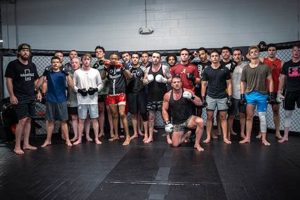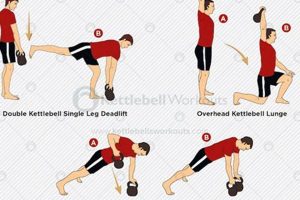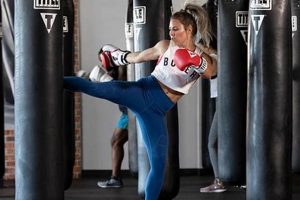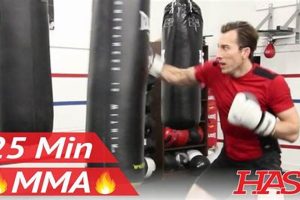Equipment designed specifically for mixed martial arts training encompasses a broad range of items, from protective gear like hand wraps, gloves, shin guards, and headgear, to training aids such as heavy bags, focus mitts, grappling dummies, and resistance bands. These items serve distinct purposes in skill development, conditioning, and injury prevention.
Effective preparation for the demanding physical and technical aspects of mixed martial arts necessitates specialized equipment. Such equipment not only mitigates the risk of injury during training but also allows athletes to refine techniques, build strength and endurance, and enhance overall performance. The evolution of these tools has mirrored the development of the sport itself, progressing from basic protective gear to sophisticated training aids designed to optimize specific skill sets.
The subsequent sections will delve into specific categories of mixed martial arts training equipment, exploring their individual functions, benefits, and selection criteria.
Essential Tips for Selecting MMA Training Accessories
Choosing appropriate training equipment is crucial for optimizing performance and minimizing injury risk in mixed martial arts. The following tips offer guidance for making informed decisions.
Tip 1: Prioritize Quality and Durability: Investing in well-constructed equipment from reputable brands ensures longevity and provides reliable protection during intense training sessions. Substandard materials can compromise safety and performance.
Tip 2: Consider Individual Needs and Training Goals: Equipment selection should align with specific training objectives. A grappler may prioritize high-quality grappling dummies, while a striker might focus on durable heavy bags and focus mitts.
Tip 3: Ensure Proper Fit and Comfort: Ill-fitting equipment can hinder movement and increase the risk of injury. Gloves, headgear, and shin guards should fit snugly but not restrict circulation or range of motion.
Tip 4: Research and Compare Different Products: Exploring various brands, models, and user reviews provides valuable insights into the strengths and weaknesses of different products, facilitating informed purchasing decisions.
Tip 5: Seek Expert Advice: Consulting experienced coaches or trainers can provide personalized recommendations based on individual needs and training styles.
Tip 6: Maintain and Clean Equipment Regularly: Proper care extends the lifespan of training gear and maintains hygienic training conditions. Cleaning gloves and other protective gear after each use is essential.
Tip 7: Budget Wisely: While quality is paramount, it’s important to establish a budget and prioritize essential items. Start with fundamental protective gear and gradually invest in additional training aids as needed.
Adhering to these guidelines ensures athletes can equip themselves with the necessary tools to train effectively, improve performance, and minimize the risk of injury.
By understanding the importance of appropriate equipment selection and maintenance, athletes can maximize their training potential and achieve their goals in the challenging world of mixed martial arts.
1. Protection
Safety is paramount in the demanding training regimens of mixed martial arts. Protective accessories play a crucial role in mitigating the risk of injuries, allowing athletes to train consistently and effectively. These specialized pieces of equipment safeguard vulnerable areas of the body, reducing the impact of strikes and grappling maneuvers.
- Headgear:
Headgear protects against facial lacerations, concussions, and cauliflower ear. Varying designs cater to different training needs, from sparring to grappling. Properly fitted headgear is essential for optimal protection and unobstructed vision.
- Gloves:
Gloves safeguard the hands and wrists during striking, grappling, and clinch work. Different glove types exist for specific purposes: bag gloves for heavy bag training, sparring gloves for partner drills, and competition gloves for professional bouts. Appropriate glove selection and proper hand wrapping techniques are crucial for injury prevention.
- Shin Guards:
Shin guards protect the lower legs from impact during kicking and checking techniques. They also minimize the risk of abrasions and contusions during grappling exchanges on the mat. Securely fastened shin guards are vital for unrestricted movement and effective protection.
- Mouthguards:
Mouthguards are essential for protecting the teeth, gums, and jaw from impact. Custom-fitted mouthguards offer superior protection and comfort compared to generic boil-and-bite options. Wearing a mouthguard during all sparring and competition scenarios is crucial for preventing dental injuries and concussions.
The strategic use of protective accessories is fundamental to safe and effective training in mixed martial arts. By employing appropriate protective gear, athletes can minimize injury risk and focus on developing their skills and physical conditioning. Investing in high-quality, properly fitted protective equipment demonstrates a commitment to long-term training health and athletic longevity.
2. Performance Enhancement
Maximizing performance in mixed martial arts requires dedicated training and the strategic use of specialized accessories. These tools go beyond mere injury prevention, actively contributing to enhanced speed, power, endurance, and overall fighting proficiency. Understanding the connection between specific training accessories and performance enhancement is crucial for athletes seeking to optimize their training regimens.
- Strength and Power Development:
Weighted gloves, resistance bands, and weighted vests augment strength and power development by adding resistance to training exercises. Weighted gloves increase punching power and speed, while resistance bands enhance muscle activation during various movements. Weighted vests improve explosive power and overall strength conditioning. These tools contribute to enhanced striking force, takedown explosiveness, and overall athleticism.
- Speed and Agility Enhancement:
Agility ladders, speed ropes, and reaction balls are instrumental in improving speed, agility, and footwork. Agility ladders enhance foot coordination and quickness, crucial for effective movement in the octagon. Speed ropes develop cardiovascular fitness and foot speed, contributing to overall endurance and agility. Reaction balls improve hand-eye coordination and reaction time, essential for anticipating and responding to opponents’ movements.
- Endurance and Conditioning:
Medicine balls, kettlebells, and plyometric boxes contribute to improved cardiovascular fitness, muscular endurance, and overall conditioning. Medicine ball exercises enhance core strength and explosive power. Kettlebell training builds functional strength and endurance, while plyometrics develop explosive power and improve overall athleticism. These tools enhance an athlete’s ability to maintain high-intensity performance throughout a fight.
- Technique Refinement:
Focus mitts, heavy bags, and grappling dummies facilitate technique refinement and skill development. Focus mitts allow trainers to simulate realistic striking scenarios, improving accuracy, timing, and combinations. Heavy bags develop power, technique, and endurance in striking. Grappling dummies aid in practicing takedowns, submissions, and ground control techniques. These tools allow athletes to hone their skills and develop a more well-rounded fighting style.
Strategic incorporation of these performance-enhancing accessories into a comprehensive training program contributes significantly to improved fighting proficiency. By leveraging these tools effectively, athletes can maximize their potential, gaining a competitive edge in the demanding arena of mixed martial arts.
3. Skill Development
Mastery of mixed martial arts necessitates the development of a diverse skill set encompassing striking, grappling, and overall fighting strategy. Specialized training accessories play a critical role in honing these skills, providing athletes with the tools to refine techniques, improve execution, and develop a well-rounded fighting style. These accessories facilitate targeted training, allowing athletes to isolate specific skills and practice them repeatedly, ultimately leading to improved performance and a deeper understanding of the intricacies of mixed martial arts.
- Striking Refinement:
Developing precise and powerful strikes is fundamental to success in mixed martial arts. Heavy bags, focus mitts, and double-end bags serve as invaluable tools for refining striking techniques. Heavy bags allow athletes to practice power generation and technique execution. Focus mitts, held by a training partner, enable the development of accuracy, timing, and combinations. Double-end bags enhance hand-eye coordination and reaction time. These tools collectively contribute to improved striking proficiency, enabling athletes to deliver impactful blows with precision and speed.
- Grappling Enhancement:
Ground control, takedowns, and submissions form the core of grappling in mixed martial arts. Grappling dummies, wrestling mats, and resistance bands provide athletes with the means to enhance their grappling abilities. Grappling dummies allow for repetitive practice of takedowns, submissions, and positional control. Wrestling mats provide a safe and controlled environment for ground-based training. Resistance bands aid in developing the strength and flexibility required for effective grappling. These tools collectively contribute to improved grappling proficiency, enabling athletes to control opponents on the ground and execute successful submissions.
- Strategic Development:
Strategic thinking and tactical execution are crucial for success in the dynamic environment of a mixed martial arts contest. Training accessories such as Thai pads, kicking shields, and sparring gear contribute to the development of strategic thinking. Thai pads allow trainers to simulate various striking attacks, enabling athletes to practice defensive maneuvers and counter-striking techniques. Kicking shields aid in developing powerful and accurate kicks, while sparring gear allows for realistic fight simulations, promoting strategic thinking and tactical adaptation under pressure. These tools help athletes develop the ability to analyze opponents, anticipate their movements, and execute effective strategies in real-time.
- Footwork and Movement:
Agile footwork and efficient movement are essential for maintaining balance, creating angles of attack, and evading opponent strikes. Agility ladders, speed ropes, and cones provide athletes with the tools to enhance their footwork and movement patterns. Agility ladders improve foot speed, coordination, and agility. Speed ropes develop cardiovascular endurance and footwork efficiency. Cones are used to create drills that simulate movement patterns within the octagon. These tools contribute to improved mobility, allowing athletes to move fluidly and effectively within the fighting space.
The strategic utilization of these training accessories plays a pivotal role in the development of a well-rounded and skilled mixed martial artist. By dedicating time and effort to training with these tools, athletes can refine their techniques, enhance their strategic thinking, and ultimately achieve a higher level of proficiency in the multifaceted discipline of mixed martial arts.
4. Durability and Quality
The rigorous demands of mixed martial arts training necessitate equipment built to withstand consistent, high-intensity use. Durability and quality are paramount considerations when selecting training accessories, directly impacting both safety and performance. Investing in robust, well-constructed equipment ensures longevity, minimizes the risk of equipment failure during crucial training moments, and ultimately contributes to a more effective and rewarding training experience. Substandard equipment can compromise safety, hinder progress, and necessitate frequent replacements, proving costlier in the long run.
- Material Integrity:
The materials used in the construction of training accessories dictate their ability to withstand wear and tear. High-quality leather, reinforced stitching, and durable synthetic materials are essential for longevity. For example, gloves constructed with premium leather and reinforced stitching will withstand repeated impacts and grappling sessions far better than those made with lower-grade materials. This directly translates to enhanced safety and a longer lifespan for the equipment.
- Construction Quality:
The construction methods employed in manufacturing significantly influence the overall durability of training accessories. Reinforced seams, double-stitching, and meticulous attention to detail are indicators of high-quality construction. A well-constructed heavy bag, for instance, will maintain its structural integrity and filling distribution even after countless strikes, while a poorly constructed bag may tear or lose its shape prematurely. Superior construction ensures consistent performance and extended lifespan.
- Protective Capabilities:
The protective capabilities of training accessories are inextricably linked to their durability and quality. Headgear, shin guards, and gloves designed with high-quality protective padding and robust outer layers offer superior protection against impact and abrasion. For example, high-density foam padding within shin guards effectively dissipates impact force, minimizing the risk of injury during sparring. Durable and well-designed protective gear is crucial for safeguarding athletes during intense training sessions.
- Long-Term Cost-Effectiveness:
While high-quality training accessories may entail a higher initial investment, they often prove more cost-effective in the long run. Durable equipment requires less frequent replacement, reducing overall expenditure over time. Investing in a high-quality heavy bag, for example, may be more expensive initially, but its extended lifespan compared to a cheaper, less durable alternative ultimately saves money. Prioritizing quality ensures long-term value and consistent performance.
The durability and quality of training accessories are not merely peripheral considerations but rather fundamental components of effective mixed martial arts training. Investing in well-constructed, durable equipment enhances safety, improves performance, and contributes to a more rewarding and efficient training experience. Prioritizing quality ensures that athletes have the tools they need to train consistently, push their limits, and achieve their full potential in the demanding sport of mixed martial arts.
5. Specific Training Needs
Individual training requirements within mixed martial arts vary significantly based on factors such as fighting style, physical attributes, experience level, and specific areas of development. The connection between specific training needs and the selection of appropriate accessories is crucial for optimizing training effectiveness and achieving desired outcomes. A tailored approach to equipment selection, informed by individual needs, ensures that athletes have the tools necessary to address specific weaknesses, enhance strengths, and maximize their overall potential. Ignoring specific training needs can lead to inefficient training, hinder progress, and potentially increase the risk of injury.
A striker focusing on developing punching power and speed may prioritize weighted gloves, heavy bags, and focus mitts. These accessories directly contribute to enhancing striking technique, power generation, and hand-eye coordination. Conversely, a grappler focused on improving takedowns and submissions would benefit from grappling dummies, wrestling mats, and resistance bands, facilitating the development of grappling-specific skills and techniques. A fighter preparing for an upcoming competition might incorporate specialized training equipment that mimics the competitive environment, such as competition gloves and specific types of protective gear. These examples illustrate the importance of aligning equipment choices with individual training objectives.
Understanding the nuanced relationship between specific training needs and accessory selection is fundamental to maximizing training effectiveness and achieving desired outcomes in mixed martial arts. A tailored approach to equipment selection, guided by individual goals and areas of focus, empowers athletes to optimize their training regimens, address specific weaknesses, and ultimately reach their full potential within the demanding and multifaceted discipline of mixed martial arts. Failure to consider specific needs can lead to plateaus in progress and an increased risk of injury due to inadequate or inappropriate equipment usage. Therefore, careful consideration and selection of training accessories based on individual requirements are paramount for success in mixed martial arts.
Frequently Asked Questions about MMA Training Accessories
This section addresses common inquiries regarding the selection, use, and maintenance of mixed martial arts training equipment.
Question 1: How does one determine the appropriate size and fit for protective gear like gloves and headgear?
Proper fit is crucial for both safety and performance. Manufacturers typically provide sizing charts based on weight and hand circumference for gloves. For headgear, measuring head circumference is essential. Consulting with experienced trainers or equipment specialists can provide personalized guidance.
Question 2: What are the key differences between bag gloves, sparring gloves, and competition gloves?
Bag gloves are designed for heavy bag training and focus mitt work, prioritizing hand protection and durability. Sparring gloves offer increased padding to protect both the wearer and training partner. Competition gloves are generally lighter and less padded, optimizing speed and impact force while adhering to regulatory standards.
Question 3: How often should training equipment be cleaned and maintained?
Regular cleaning and maintenance are essential for hygiene and equipment longevity. Gloves, hand wraps, and other protective gear should be cleaned after each use. Heavy bags and other training aids should be inspected regularly for wear and tear and cleaned periodically to prevent bacterial growth.
Question 4: What are the essential accessories for beginners starting MMA training?
Beginners should prioritize essential protective gear, including gloves, hand wraps, shin guards, and a mouthguard. A gi or rash guard is also recommended for grappling training. As training progresses, additional equipment such as focus mitts, heavy bags, and specialized training aids can be incorporated.
Question 5: How does one choose between different types of heavy bags, such as free-standing, hanging, or angled bags?
The choice of heavy bag depends on individual training goals and available space. Free-standing bags offer portability and convenience. Hanging bags provide a more realistic swinging motion, while angled bags are ideal for practicing uppercuts and body shots.
Question 6: Where can reliable information regarding the selection and use of MMA training accessories be found?
Reputable martial arts equipment suppliers, experienced coaches and trainers, and online resources specializing in combat sports equipment can provide valuable insights. Peer-reviewed articles and scientific studies related to sports equipment and injury prevention can also offer valuable information.
Investing in appropriate and high-quality training accessories is crucial for both safety and performance in mixed martial arts. Informed decisions regarding equipment selection and maintenance contribute significantly to training effectiveness and long-term athletic development.
This concludes the frequently asked questions section. The following section will offer concluding remarks.
Conclusion
Appropriate equipment selection is essential for safe and effective mixed martial arts training. Protective gear mitigates injury risks, while specialized training aids enhance skill development, improve physical conditioning, and optimize overall performance. Careful consideration of individual training needs, equipment quality, and proper maintenance ensures athletes have the tools necessary to achieve their training objectives.
Strategic investment in mixed martial arts training equipment represents an investment in an athlete’s long-term development and success within the sport. The correct tools empower athletes to train smarter, perform better, and minimize the risk of injury, ultimately paving the way for continued growth and achievement in the demanding world of mixed martial arts.







